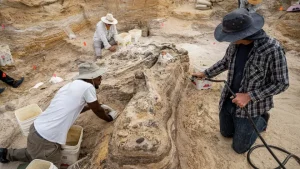In the annals of prehistoric discovery, a recent find in northern Florida has set the scientific community abuzz. A team of dedicated researchers and volunteers unearthed a treasure trove of ancient fossils in the region near Gainesville, shedding light on the long-gone megafauna that once roamed the land.

Among the remarkable discoveries is a prehistoric elephant graveyard dating back roughly five and a half million years. The fossils belong to gomphotheres, extinct relatives of elephants that roamed the ancient landscapes of Florida. These formidable creatures, part of the proboscidean family that includes modern elephants, offer a unique glimpse into the prehistoric era of North America.

Described as a “once-in-a-lifetime find” by Jonathan Bloch, curator of vertebrate paleontology at the Florida Museum of Natural History, the complete gomphothere skeleton uncovered at the site is among the most exceptional in North America. The significance of this discovery lies not only in its rarity but also in the insights it provides into the evolutionary history of these majestic creatures.

Gomphotheres first appeared around 23 million years ago during the early Miocene period and eventually made their way into North America via the Bering land bridge. Traversing continents and adapting to diverse environments, these elephant-like creatures thrived until the pressures of rapid climate change and human activities led to their extinction.

The excavation efforts at the Montbrook Fossil Dig have revealed multiple complete skeletons, including an adult and several juveniles. The sheer size of these ancient beasts is awe-inspiring, with the adult gomphothere estimated to have stood at around eight feet tall at the shoulders, sporting tusks that added to its imposing stature.

The fossilized remains found at the site suggest that these gomphotheres were not all victims of a single catastrophic event but rather accumulated over time in the ancient riverbed. The fossils of other prehistoric creatures, such as land-dwelling camels, rhinoceroses, and marine species, further enrich the paleontological tapestry of the region.

As the excavation and research continue, scientists are eager to piece together the puzzle of prehistoric Florida and showcase the newly discovered gomphothere alongside other iconic megafauna at the Florida Museum of Natural History. This extraordinary find not only expands our understanding of the ancient world but also underscores the importance of preserving and studying the remnants of our planet’s distant past.

In conclusion, the Montbrook gomphothere represents a fascinating chapter in the history of North America’s prehistoric fauna, offering a rare glimpse into a bygone era when giant elephants roamed the land.





